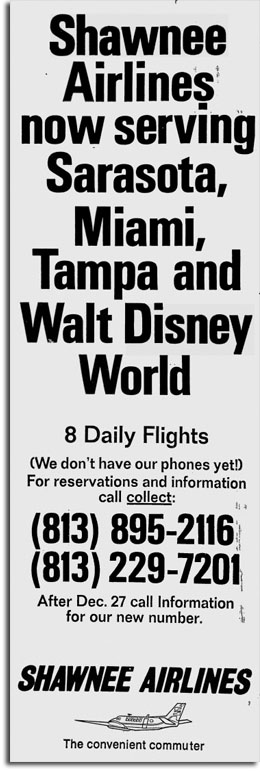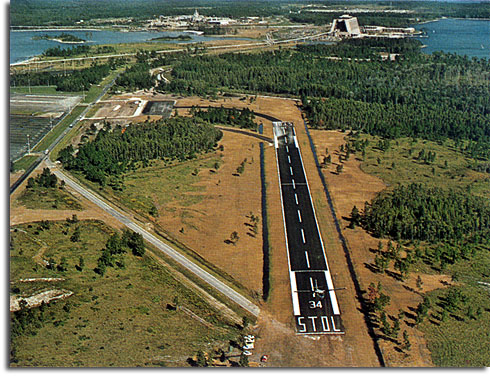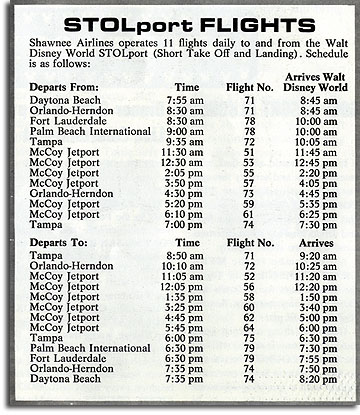 It’s long been known that part of Walt Disney’s plan for his newly-purchased land in Florida was an “airport of the future” that would service both the industries and residents of his planned city, EPCOT, as well as the guests to his new resort and theme park.
It’s long been known that part of Walt Disney’s plan for his newly-purchased land in Florida was an “airport of the future” that would service both the industries and residents of his planned city, EPCOT, as well as the guests to his new resort and theme park.
The airport can be seen to the bottom of the diagram on the right. Its location, at the southernmost end of the Walt Disney World development, corresponds roughly to the current site of the town of Celebration. As you can see, the airport would be linked by a central monorail line to a transportation hub and entrance plaza, the planned industrial park, EPCOT city, and the resort area and theme park.
The desire for Walt Disney World to have its own airport wasn’t as arbitrary as it might seem today. In 1971, when the resort opened, what has now become the bustling Orlando International Airport was known as the Orlando Jetport at McCoy – a small commercial airstrip that operated out of a portion of the much larger McCoy Air Force Base. For a passenger terminal, the Jetport had inherited an old missile hangar from the Air Force; even after the government decommissioned the base in 1975 and transferred the entire site to the city of Orlando (leaving as a legacy its IATA code, MCO, which the airport uses to this day), air travelers arriving at the newly-named Orlando International Airport were greeted by the same primitive Quonset hut terminal until more modern facilities opened in 1981. It’s easy to see how Disney, who expected guests to arrive by air from across the world, might see the need for an advanced and modern airport of their own.
Part of the legislation that created the Reedy Creek Improvement District did indeed grant Disney the powers to build and operate its own airport, but like so many of Walt’s other dreams it never came to pass. For a brief time in the early 1970s, though, it was possible for the jet set to wing their way to the Vacation Kingdom of the World courtesy of Disney’s very own landing strip – the Lake Buena Vista STOLport.
This facility, a private-use airport designated “DWS” by the IATA, was essentially a featureless 2000-foot landing strip and taxiway. For Disney fans, though, it’s a mysterious glimpse into a long-lost era and a future that might have been.
In the late 1960s and early 1970s, there was a movement to mitigate the growing traffic problem on America’s highways by building a national network of STOLports to provide inter-city regional transportation. STOL, or Short Take-Off and Landing, refers to small aircraft that can land on or take off from shorter airstrips than standard commercial jetliners. This would, theoretically, enable STOL facilities to be built on a wider scale and in more developed areas that typical airports. People would then be able to avoid traffic jams on the roads in their area by making short trips on a variety of commuter airlines. In the early 1970s, this approach was being strongly encouraged by both the Florida Department of Transportation and then-Governor Reuben Askew. ((St. Petersburg Times – Jun 29, 1971)) The state had proposed a demonstration route from Miami to Walt Disney World in March of 1971, with the eventual goal of 15 to 20 STOLports in central and southern Florida to alleviate inter-city traffic. ((The Palm Beach Post – Mar 13, 1971))
As part of their effort to become an example of cutting-edge city planning, a STOLport was added to the master plan for Walt Disney World. Located to the eastern side of World Drive across from the Magic Kingdom’s parking lot, the facility would allow for regularly-scheduled daily service to a number of regional airports, as well as providing connector flights to the main Orlando jetport at McCoy and Tampa International Airport. True to Disney’s desire to innovate, the resort’s STOLport was the nation’s first. Intended as the nexus of a Florida-wide network of similar facilities, it would not only provide a convenience to arriving travelers, but also hoped to allow Disney guests “greater opportunities to visit all areas of the state.” ((The Miami News – Jun 28, 1971))
The Disney company announced their plans for the airstrip on June 28th, 1971, with construction to commence immediately. The Lake Buena Vista STOLport, as it was to be known, would eventually consist of the 2000-foot runway and a terminal building. Donn Tatum, at the time president of Walt Disney World, said that the STOLport would be open only to commercial air traffic, with a second airport for corporate and private flights to be built later. Neither the terminal or this second airport were ever built.
Disney had high hopes for the service, with Tatum stating, “We believe the service will help demonstrate the effectiveness and economic feasibility of STOL aircraft.” Tatum also announced that plans were underway with Eastern Airlines, then the official airline of the resort and consultant on the STOLport project, so that guests could buy their tickets to Walt Disney World anywhere in the world and have their luggage checked directly through to the resort.
 Disney also announced an agreement with Shawnee Airlines to provide service to the STOLport from a variety of locations in the area. The small commuter airline would ferry passengers on its fleet of de Havilland DHC-6 Twin Otters. These reliable planes, carrying 19 passengers per flight, remain in production to this day and are favorites of commuter airlines and bush pilots alike (possibly because they have one of the greatest airplane names of all time). Disney would soon add service by another regional outfit, Executive Airlines.
Disney also announced an agreement with Shawnee Airlines to provide service to the STOLport from a variety of locations in the area. The small commuter airline would ferry passengers on its fleet of de Havilland DHC-6 Twin Otters. These reliable planes, carrying 19 passengers per flight, remain in production to this day and are favorites of commuter airlines and bush pilots alike (possibly because they have one of the greatest airplane names of all time). Disney would soon add service by another regional outfit, Executive Airlines.
Executive, flying their own fleet of “Twin Otters”, announced in July of 1971 that they would begin service that September from St. Petersburg’s Albert Whitted Airport to Tampa. This route, billed as “the first operating portion of the Disney World STOLport network,” ((The St. Petersburg Independent – Jul 14, 1971)) would be extended to Walt Disney World upon its October opening.
 A Shawnee Airlines de Havilland DHC-6 Twin Otter (Photo found here)
A Shawnee Airlines de Havilland DHC-6 Twin Otter (Photo found here)Inaugural service to Walt Disney World by both Shawnee and Executive began on the morning of Friday, October 22nd, 1971. ((Sarasota Herald-Tribune – Oct 24, 1971)) The occasion was marked by a luncheon ceremony, where the state of Florida presented Disney with STOLport license No. 1. An array of local and state politicians and officials were on hand, as well as executives from the airlines and companies involved. With the array of officials, stewardesses, reporters, and others, there was a level of pomp and circumstance rarely warranted by a 2000′ strip of tarmac in the middle of the central Florida scrub.
Charles Bragg, president of Executive, said that he believed that day’s trip from downtown St. Petersburg’s Albert Whitted Airport to Walt Disney World to be the first-ever STOL to STOL flight. Col. John W. Dregge, director of the Office of Community and Congressional Relations for the Civil Aeronautics Board, proclaimed that STOL would be the “next breakthrough in air transportation.” Even the president of de Havilland Aircraft of Canada, Ltd. was present to help promote the Twin Otters.
Disney announced that STOL service would commence with around 26 flights daily. Guests were to be transported to the airstrip by shuttle bus; at the time the facility consisted solely of the runway, taxi ramp, and 4-plane parking lot. Again Disney re-iterated their plans to expand the STOLport in the future with a passenger terminal, baggage-handling facilities, full instrumentation, and lighting for around-the-clock operations.
But while Executive announced plans for limited service through October 30th, with service expanding again throughout November, the excitement was short lived. On December 9th, 1971, Executive eliminated their Southern Region which included service within Florida. A day later, on December 10th, they filed for bankruptcy. ((Sarasota Herald-Tribune – Dec 11, 1971)) Shawnee stepped in to fill the gap, taking over Executive’s service to Sarasota-Brandenton Airport. Shawnee’s president David C. Latham said at the time that there hadn’t been room in the Florida economy for two commuter airlines, and the demise of Executive would improve his own airline’s bottom line.
Even then, though, the writing might have been on the wall for Disney’s commuter service; Latham’s optimistic economic prediction was that Shawnee would “come close” to breaking even in 1971 and might possibly turn a profit the next year. He indicated that the Disney route, while promising, would not make money for at least a year and was dependent on joint-fare arrangements with major airlines to succeed.
Can you guess where this is going?
 Inspiring confidence: This ad for Shawnee Airlines appeared in the Sarasota Herald-Tribune on December 19th, 1971
Inspiring confidence: This ad for Shawnee Airlines appeared in the Sarasota Herald-Tribune on December 19th, 1971By 1972, Shawnee was struggling to restore service to Walt Disney World from St. Petersburg in the wake of Executive’s bankruptcy. The airline planned to restore unscheduled daily service to the city by mid-June, following an “intensive advertising campaign.” ((The St. Petersburg Evening Independent – May 11, 1972)) Apparently officials in St. Petersburg blamed the failure of Executive’s service on a lack of advertising, and Latham hoped to sell residents on the convenience of the half-hour flight to Disney World.
The airline’s plan for the new route was to price flights on a sliding scale from $19 to $28, with the cost depending on the number of passengers aboard; they hoped to spur group sales with a package deal that included admission to the Magic Kingdom and a book of attraction tickets. Flights would remain unscheduled until Shawnee determined local demand; they had recently started regularly-scheduled flights out of Tampa, but that forced them to fly even with empty seats and kept ticket prices high ($28). Another ominous quote from Latham: “We think this is the best way… any other and it would be a huge cash expense – possibly catastrophic.”
But try as they might, Shawnee couldn’t make their commuter service profitable. The tourism boom resulting from the opening of Walt Disney World led major carriers to increase their flights to and within Florida, and their higher capacity forced the local airlines out of business. Shawnee discontinued their service to Sarasota, Miami, Daytona Beach, Fort Myers, and Pensacola in November 1972. ((Sarasota Herald-Tribune – Nov 3, 1972)) By the end of December, Shawnee went out of business. Latham blamed the new-found success of the major airlines in Florida, claiming that small commuter routes would never work without government subsidies. ((Sarasota Herald-Tribune – Nov 3, 1972)) Perhaps most tellingly, Disney officials said at the time that the loss of STOL service would have “no significant effect” on attendance.
The last scheduled STOL flights took place Thursday, December 28th, 1972. Latham kept a skeleton crew at Shawnee to honor a commitment to provide service for a convention of the International Newspaper Advertising Executives Association at Walt Disney World from January 16-24th, but after that all STOL service ceased.
I can find no reference after this time of Disney attempting to restore service to the route; given its lack of profitability and the absence of any thriving regional carriers that’s probably not a surprise. By this time, the political and economic troubles of the 1970s had begun, and the company’s plans for Disney World began to be scaled back in the general discombobulation of the Card Walker era. By the time of the oil crises, the idea of affordable short-range air routes became completely impractical. Add to that the fact that by the end of the decade Orlando was well on its way to expanding its own International Airport, and it starts to seem that it was simply never in the cards for the Lake Buena Vista STOLport.
Any future thoughts of using the facility were precluded when monorail service was expanded to EPCOT Center in 1982. The track’s route, which runs southward along World Drive from the Transportation & Ticket Center, passes perilously close to the former STOL runway and any further aircraft landings were prohibited (whether this is due to FAA regulations or the concerns of Disney lawyers, I don’t know). For well over a decade now, the airstrip has been used for a variety of purposes from providing a staging area for construction equipment or shipping containers to a parking lot for buses. It’s been paved over with concrete, but it’s still there – most guests probably don’t even notice it as they’re headed to the Magic Kingdom.
Amusingly, the STOLport was not eager to go quietly – at least in the realm of government maps and charts. It appeared on USGS surveys and maps throughout the 1980s and 90s, sometimes still labeled by its original name and sometimes just as “landing strip.” This seems to have changed in the wake of 9/11; since 2003 the FAA has, at the behest of Disney, imposed a mandatory no-fly zone over the property in Florida. It appears that all references to the airport have finally been removed from official charts – so much for the dream of flying into the Vacation Kingdom, pulling up to the terminal, and taking a short ride to your Disney resort.
The idea of what could have been is rather appealing, if you think about it – I picture a low-slung, air-conditioned terminal straight out of the 1970s… Eastern Airlines posters everywhere… muzak from If You Had Wings playing in the background… and possibly complimentary orange juice from the Florida Citrus Growers. Look, there’s the Orange Bird! Straight from the Sunshine Tree!
 One last look at the STOLport – this USGS image from 2007 shows the former airstrip filled with what appears to be shipping containers or buses
One last look at the STOLport – this USGS image from 2007 shows the former airstrip filled with what appears to be shipping containers or busesOne last amusing tale from the Lake Buena Vista STOLport before we go. The facility was not without its controversies; before it opened, officials from Kissimmee protested Disney’s plans, claiming that “skies are just too crowded.” ((Daytona Beach Morning Journal – Jul 29, 1971)) More likely, the politicians from other cities were concerned that Disney’s new airstrip would hinder their efforts to built a $350,000 expansion to their own airport.
But the best story I’ve found about the STOLport comes from the Lakeland Ledger, on November 7, 1971. It’s a story by someone named Don Emerson, who appears to have had a regular column called “Air Scoop.” I reprint it here in its entirety:
Disney World Warns Pilots To Avoid STOLport
This week’s mail brought us this letter from Walt Disney World. We were hoping it contained an invitation to do an imitation of Grumpy, Sneezy, Sleepy or even Dopey in which we have had a little experience in each characterization at one time or another. Instead it read as this. “Dear Sir: This letter is to request your assistance in informing all AIRMEN of the status of the Lake Buena Vista STOLport located at Disney World.
“The STOLport is a private facility open only to the air carriers that have contractual agreements with Walt Disney World Company. Any landing by an unauthorized aircraft will be considered a violation of private property and the appropriate civil action taken.
“I will appreciate your assistance in informing fixed base operators, flying clubs, and airmen in your area of this information.” There it is. No landing at Walt Disney World STOLport (Short Takeoff & Landing airport). Recently a pilot made an unauthorized landing there, parked his Lakes Amphibian aircraft. He spent most of the day savoring the wonders and excitement of the fabulously fantastic funland. Returning to the landing strip, he did not see his aircraft. Asking where it could possibly be, he was told it was at a nearby airport. He said this couldn’t be as he had the ignition keys. Oh yes, it could be for aircraft mechanics were called, the wings removed and it was trucked off to a public airport and reassembled and there was his bill to prove it. This may seem to be drastic measures but when an airport is marked “Private” on the air charts, that’s exactly what it means and a landing is trespassing. Many have had the experience of having their auto removed by a tow-truck from a no-parking area but few ever thought of aircraft being in the same category.
Another regulation pilots are breaking at Walt Disney World is the FAA requirement of 1,000 feet minimum altitude. You can understand the Disney people’s concern with aircraft circling low overheard of thirty thousand visitors. A mid-air collision or engine malfunction would endanger hundreds of people. For their protection, personnel are stationed in Cinderella’s Castle tower whereby accurate readings, altitude and aircraft registration number are recorded and violations are reported to the Federal Aviation Administration for corrective action. Another thing to bear in mind is its private airport is directly under Airway Route V-152S that is heavily traveled between Lakeland and Orlando. This means even airlines using the Lakeland Omni Range are moving back and forth along this line or radial. So, a pilot really has no business to jeopardize aircraft in this flyway or the visitors on the ground by circling the area, for he will be probably looking down and not out and around to see if other craft are doing the same as he. Usually, a pilot circles to the left as he sits on that side of the aircraft and can see better when banking to the left. But, and here’s where the real problem is, the passenger on the right wants to get a few pictures so the pilot banks or turns to the right… You just picture it. Half the cars on a racetrack racing in the opposite direction and everybody looking straight down! Stay safe near Walt Disney World and stay out of trouble.
Buzzing the castle? Spotters above the Magic Kingdom, looking for hostile aircraft? Those are stories I’d like to hear. Actually, that column might do a pretty good job of illustrating why Disney was so willing to shut down the STOLport and why the no-fly zone might not be so draconian after all. Imagine what guests do in traffic with their strollers and ECVs and transpose that to the skies above. Yikes.
But taking apart an entire airplane and having it moved to another airport? Wow. Don’t ya just miss those days when Disney was willing to go the extra mile?
Find out more info about the Lake Buena Vista STOLport here.













Very interesting piece! There was so much I didn’t know about the airstrip I’d seen through the trees. What a great story. Thanks
And this is why Progress City is the gold standard. Great article. Thanks.
Great piece. Many people don’t know about the STOLport, or the planned airport that was to follow. As a side note, as late as through the nineties, Disney ran a small plane above all of the parks in the area. First, Water Mania, then Sea World. Then they headed over and did Wet ‘n Wild and Universal. We all knew of it. It came by every day to note attendance in the parks by counting our parking lots. Usually happened before noon.
J. Jeff Kober
DisneyatWork.com
Another excellent article.
Just to add a few notes:
A primary intend customer of the STOLport was supposed to have been the Vacation Home/Corporate Housing development that eventually became the Disney Village complex. They were originally designed to be sold as vacation homes, executive housing and used as a conference center/corporate retreat. When the Village was turned into retail accommodations, the need for parking lots of fancy business planes went away.
Even as late as the early 1990’s, Disney relooked at opening an airport on the southern chunk of property. When WDW first opened, the vast majority of guests arrived by car, but with airline deregulation, soaring gas prices and the death of the two week vacation, more people began to fly. To serve all these guests, airlines first used large jets to move large masses from large hubs – anyone remember when all those DC-10s and L-1011’s that used to frequent Orlando. Such large jets require a large airport, hence the growth of MCO.
However with the development of longer range regional jets, the airlines began offering smaller planes flying directly from many more cities all up and down the east coast. Disney thought this might be a trend they could capitalize on as part of the “lock the guests on property” strategy. Instead of flying to Orlando and Miami and having to connect to a Shawnee puddle jumper (or worse, getting a rental car and the freedom to drive off-property), you would fly directly from Chicago or Baltimore or Atlanta or where right to WDW. There you would find a spiffy Disney terminal ready to check you in and give you your park tickets while your luggage was whisked right from the plane to your hotel. But in the end, it was just one of many blue sky idea that Euro Disney killed.
Instead, once Disney decided the land was too expensive to develop for resort use and because the southern section was in less-Disney-friendly Osecola County, Disney dumped the property in the Celebration subdivision fiasco. By that time any thought of “big ideas” and “world-class resort development” had been cast aside in the search for quick and easy cash.
Agreed with Sam. Incredible article. There’s so much I have left to learn about the original Disney World plans. Thanks for your research, Michael.
Thanks so much for the nice words, guys – this was a fun one (although it took forever to write!).
Jeff K: That’s hilarious. The Disney spyplane program!
AV: Don’t even get me started on Celebration… grr. Although, as always, you bring up an excellent point and something that makes me slap my head for leaving it out of the story. The plans for executive/corporate housing at LBV were an at-the-time unstated but important aspect of the STOLport. All those Grand Vista Homes had to get filled somehow! This also explains perfectly something that I found amusing when I was researching the story – it was called the Lake Buena Vista STOLport even though it was located in the city of Bay Lake, not LBV.
[…] Retroworlds – The Lake Buena Vista STOLport | Progress City, U.S.A.At its ultimate development, is planned to include An airport of the future, offering se… […]
What a wonderful blog post. Thank you very much, Michael.
Thank you!
This is a fascinating article! Thanks for posting this.
My pleasure! It’s such a weird and interesting little corner of Disney/aviation history. Thanks!
There was a third airline that flew to the Disney STOLport in late 1971 and early 1972 called VQ, which was operated by Volusia Air Service based in Daytona Beach. 2 daily round trips were operated on a Daytona-Disney-Tampa route. Their aircraft carried 4-5 people including the pilot. I can imagine that even in a 4-seater, operating from a 2000 foot runway with passengers on a hot day would have been more than a little nervewracking! http://www.flightglobal.com/pdfarchive/view/1972/1972%20-%200404.html?search=vq%20volusia
That’s fantastic research – there’s something weirdly romantic about all these tiny airlines flitting around Florida with their handful of planes. Like you said, I bet those takeoffs and landings could be touch and go on that little airstrip in Florida weather!
I can’t believe there are no photos or videos on the internet of the airplanes, landing, take off, on the ramp, etc, considering people were going on vacation and had cameras with them. Only a few promotional photos exists. Does anybody knows where to look for photos?
[…] spoken before about the Lake Buena Vista STOLport, the long-abandoned airstrip that allowed guests to fly […]
http://www.airliners.net/search/photo.search?airlinesearch=Shawnee%20Airlines&distinct_entry=true
Here’s some photos of Shawnee aircraft, not all from the WDW era. I can’t seem to find any photos of DWS though…
http://www.airlinefan.com/airline-photos/airline/2279/Shawnee-Airlines/
http://www.sunshineskies.net/shawnee.html
http://www.sunshineskies.net/sunshineskies_preview.pdf
http://www.flickr.com/search/?q=shawnee+airlines&w=all&s=int&referer_searched=1
You can read more about the history of this airport , and many others, at http://www.airfields-freeman.com/FL/Airfields_FL_OrlandoSW.htm
[…] Crawford from Progress City, USA has the penultimate article on the STOLport. STOL is the acronym for Short Take Off and Landing. This would have been the preferred […]
[…] Crawford at Progress City, USA has a very fascinating look at the short-lived STOLPort outside the Magic Kingdom parking lot. Plus, he links to an amazing 1983 EPCOT home […]
[…] this page has a bit more in-depth information, as well as […]